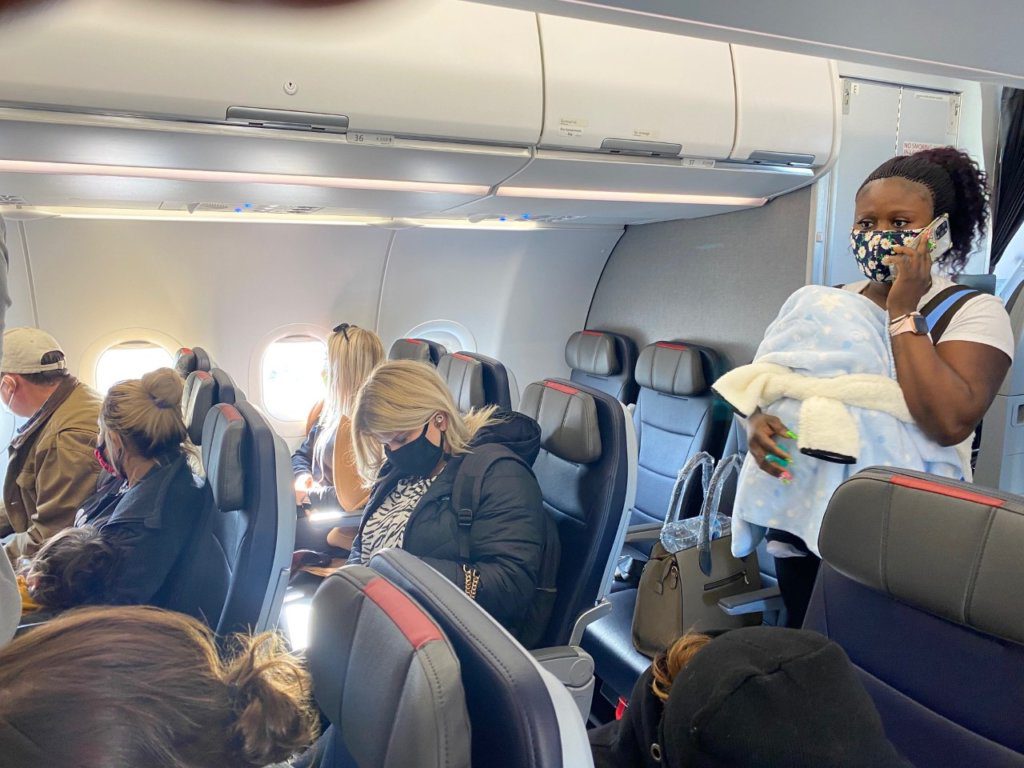Flying During COVID? Millions Take the Risk
By • December 31, 2020 0 3009

This reporter was among the millions of Americans who flew during the Christmas holidays this year, despite the COVID pandemic. There were many surprises on the way to a two-week stay with my twin sister in Santa Barbara, California, our hometown. I debated whether to go for months.
Airlines have assured passengers that their new ventilation systems are highly efficient. “I think it would be very unlikely you’d have a super-spreading event where 50 people on the flight get sick from one person,” said Dr. Henry Wu, director of Emory University’s TravelWell Center in Atlanta, quoted in a Healthline newsletter. “Unless there’s a malfunction in the ventilation system, I just think it’s very, very unlikely.”
Wearing masks and social distancing in the airport and on the plane is mandatory. Ten months into the pandemic, stories about passenger illness and death, even on crowded planes, are virtually nonexistent. “If all seats are full, the chance that you would contract the novel coronavirus is about 1 in 4,300,” according to Arnold Barnett, a statistics professor at MIT. “There is rare overt disagreement among airlines about safety matters.”
In the end, I decided to take the risk. Though there was little information about testing requirements, since I am in my 70s, my doctor scheduled a test for me at Sibley Hospital; it took 10 minutes. I put the papers documenting my negative test results in a red transparent bag in my purse for easy pullout and viewing.
I checked in for the flight online, prepaying for a large bag full of presents. Assuming there would be many delays due to social distancing and new check-in procedures, I packed a dozen masks in my flight bag, as well as sandwiches, fruit and Christmas cookies.
But nothing was as expected.
Traffic was very light and only a few cars were at the curb when we arrived at Reagan National (it took under 15 minutes from Georgetown). The no-touch check-in process meant there was no curbside help of any kind. Passengers have to schlep all their bags into the terminal, get a boarding pass and a luggage tag from the self-check-in station, then affix the tag and personally hand the bag to a surgically gloved agent behind a counter.
My regular ID, a D.C. driver’s license, was checked against my boarding pass (all the former hologram and biometric ID requirements had been waived). I was not asked a single question about possible COVID exposure during check-in. No head or wrist temperatures were taken.
It was the same at the TSA security check, which threaded precheck and regular passengers together to a single agent. Again, the agent carefully checked IDs, but asked no COVID questions.
And it was the same at the gate, where, surprisingly, every passenger — now standing in socially distanced lines waiting to board — was requested by several airline “officials” (wearing all black) to show an ID. But no COVID contact questions were asked.
My flight to Phoenix was packed almost full. Next to my window seat in the rear, a large woman sat with a child on her lap — inches away from the aisle and window passengers. This was also the case with the rows opposite and behind me. Since I am one of the millions of pining grandmothers who have been exhorted by COVID experts for almost a year not to see or get anywhere near our precious grandchildren, I found this situation more than a bit ironic. I complained. The hostess found another middle seat for the mother.
I huddled, masked, at my window seat for five hours, knowing that fellow passengers probably thought of me as a word that begins with b and rhymes with switch (especially when I actually raised the window blind). For most of the flight, passengers remained silent, sullen and sitting in the dark, staring at computer and iPhone screens. The crew announced that the lights would be off in most of the cabin. Having caused enough trouble, I curbed my journalistic curiosity to ask why.
Few people seemed to have brought food. We were given a bag with a small bottle of water and a cookie when we entered.
Masked, I waited four hours in Phoenix’s huge airport for my next flight. Only one store with expensive water and one fast-food eatery were open. No newspapers were sold in the airports either in D.C. or in Phoenix. The airline magazine smushed in the seat pocket in front of me during the flight had a label proclaiming in capitol letters: “This magazine has been treated with an antimicrobal process.”
“In the end, it’s obviously a personal decision of what is important enough to travel (for),” Emory’s Wu noted. From my perspective now, from the sunny porch of my twin’s home and taking beach walks in my hometown’s sweet eucalyptus and salt sea air, it was worth it — come what may.

